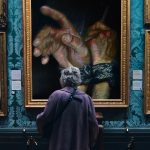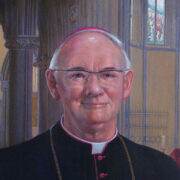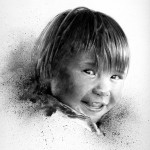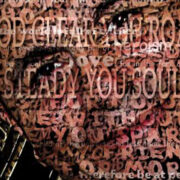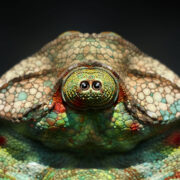
© Pierre Bamin 2007. All Rights Reserved
A Portrait of Aunty Wadia
A small homage to a wonderful woman and a reminder to me about the intricate workings of faith. Her story is like so many in the world but one I would like to share from a personal perspective.
Wadia Aboud was born in 1904 and arrived in Sierra Leone from Thelel in Lebanon in 1924. She lived with her husband and her two daughters, Adel and Emily, in the village of Lunsar, in the Marampa Chiefdom of the Port Loko district. They built their home next to the Rokel River where she and her husband worked together suppling provisions, material and tobacco to the capital city of Freetown. These goods were delivered mainly by canoe, and it was on one of these consignments in 1929 that her husband fell overboard and drowned; he was twenty-eight years old. Aunty Wadia was left devastated but continued to raise her family without the thought of remarrying, knowing life as a single mother would be, at best, extremely hard. Over the years she continued to work whilst mastering not only the local Temne language but other dialects spoken throughout the provinces. To many Missionaries, Aid-Workers and the Peace Corps she was always a welcomed presence, proving invaluable for shelter, sustenance and dialogue.
In 1940, Adel, her youngest daughter, died of measles; she was sixteen at the time. Needless to say my aunt was heartbroken and four years later she and Emily moved to Kissy Street, a suburb in the capital city of Freetown, so to be near her brother and sister-in-law. Nine years later, Emily married and in due course fell pregnant with her first child. During labour Emily was given too much chloroform (the norm for pain relief in those days) and subsequently died giving birth … the baby, Aunty Wadia’s only grandchild died shortly after from the effects….a 10lb baby boy. Overwhelmed with agonising grief she punched her face repeatedly, until black and blue. She had been witness to each child’s passing.
Fast-forward to 1984, and shortly after the death of her brother, Aunty Wadia moved to Sawpit where she worked with my grandmother selling provisions, tobacco and other items. She carried on working until her retirement at the age of ninety four.
Looking a little closer, in particular the back of her hands and wrists, there are tattoos of religious symbols. One shows a church, further up the back of the palm, ‘worry beads’ and other images now blended together of things she “can’t remember but were done in the village”. Conversations I had with her were always a joy, yet never straightforward. Answers to my questions would always take shape in the form of a parable; leaving me something to figure out as I went on my way….a little like a painting, left in part to the viewers interpretation. One thing however did remain constant; her gentle reminder to always ‘listen’, to learn, and never to forget the pain of life’s journey, etched deep under her skin.
On one visit she greeted me in a state of panic, informing me that her eyesight had finally failed her; she could no longer see. To prove the point, I was taken to her balcony where, on looking out, she claimed to no longer be able to see Lungi, a provincial town some distance across the water. Once I had explained the reason for this being ‘fog’, we toasted with a shot of brandy, putting the world to rights once more.
Conversations would often inform me of news on the street, stuff she would hear first, without even leaving her room! Her stories, whether in Krio, Temene or Arabic would flow, always with humour but for the most part ending with the pain of her losses all those years ago. Wherever she was, whatever time of the day….whether quietly sitting on her chair, chatting to locals or resting in bed, there was always a rosary at hand, passing gently through her fingers, slightly worn and mis-shapen, reflecting her very essence.
Aunty Wadia’s final years saw her bed bound, the resulting cause of a fall, yet she was steadfast and funny. Despite all this pain and anguish, she remained truly resolute in her faith until her passing on 31 May 2008.
I dedicate this painting in celebration of the human spirit!
PLEASE LIKE AND SHARE




